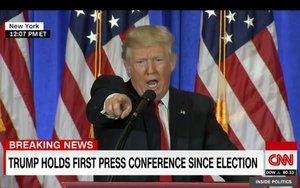
It’s a phenomenon that journalists working on any beat know all too well -- the newsmaker objecting to something you wrote and then, as punishment, putting up obstacles to future
engagement.
That’s what happened on Wednesday as Donald Trump refused to take a question from a CNN reporter, Jim Acosta, during
Trump’s news conference in New York.
Trump was getting his revenge for what he felt was unfair coverage by CNN of the formerly secret dossier about him
whose contents were published by BuzzFeed this week.
The video of Trump angrily telling Acosta to clam up while Trump called on others was shown repeatedly
on dozens of newscasts on Wednesday.
As a journalist, the story struck me as the proverbial “dog bites man” story -- journalism-speak for a story
that is so commonplace that it doesn’t pass the news test.
But journalists view the world in their own special and peculiar way. It’s easy to
understand why this confrontation made news, starting with the fact that there was video of it.
That’s the number-one qualification for news these
days. Whether it’s the president-elect berating a reporter or a cat on its hind legs dancing the Watusi, it’s all grist for the TV news mill.
Even a cynical journalist recognizes that this kind of thing tends to shock ordinary people (meaning: all people not in the news business). These people see something like this and ask
themselves: The president-elect wouldn’t take a question from CNN? My goodness -- what is the world coming to?
While the White House beat and the
television beat are two different things, I can tell you from experience that this kind of stuff happens all the time.
Half the time, you don’t have
any idea that anything you’re writing will draw an angry reaction from the people you’re writing about. At other times, you know full well that what you’re writing will tick them
off.
After publication, you wait anxiously for the fallout -- the angry phone call or blistering email from a publicist (and sometimes the newsmaker
himself), along with the vow never to connect you with the company’s top executives ever again.
Sometimes they make good on these threats and sometimes
they don’t. For now, the jury is out on whether Trump will snub CNN at future news conferences (if he has any).
The difference between this
happening on the TV beat and the White House beat are fairly obvious.
The behavior and actions of a U.S. president are much more important to a greater
number of people than the refusal of a network CEO to say yes to a request for a phone interview to discuss an upcoming TV season.
Some people might even
argue that a president giving a news conference has an obligation to call on journalists who represent news organizations with large audiences because this has long been a time-honored way for
presidents to clarify their views and actions for the American citizenry they work for.
Instead, this president(-elect) chose to have a public faceoff
with a journalist -- a confrontation that was rare, if not entirely unprecedented.
Detractors who feel that Trump comes across like a big baby at times like
this are correct. He’s a tantrum-thrower, which to many people is conduct unbecoming a United States president. They’re right about this too.
This week’s news-conference tantrum is helping to bolster my own theory of Trump that he’s basing a great deal of his behavior -- if not the direction of his entire
administration -- on George Costanza’s policy of doing exactly the opposite of what everyone expects of him.
George found success with this policy on a
memorable episode of “Seinfeld,” including landing a job with the New York Yankees.
The United States presidency is not a sitcom, of course. But
Trump threatens to turn it into one with each passing day.